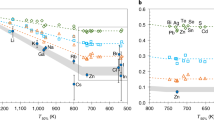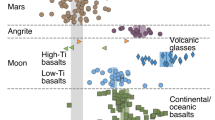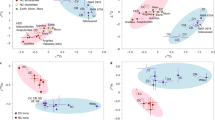Abstract
THE Ge/Ni ratios in iron meteorites range from 10−2 to 10−7 atoms/atom (ref. 1). Gallium is strongly correlated with Ge, but the total range in Ga/Ni ratio is only about 2,000. Iron meteorites tend to have Ga and Ge concentrations within various restricted ranges—thus their usefulness for the classification of iron meteorites. No other element correlates strongly with Ga and Ge. Here we point out parallels between the abundance patterns of moderately volatile elements in iron meteorites and ordinary chondrites, and discuss how these can be related to condensation processes in the solar nebula.
This is a preview of subscription content, access via your institution
Access options
Subscribe to this journal
Receive 51 print issues and online access
$199.00 per year
only $3.90 per issue
Buy this article
- Purchase on Springer Link
- Instant access to full article PDF
Prices may be subject to local taxes which are calculated during checkout
Similar content being viewed by others
References
Wasson, J. T., Meteorites—Classification and Properties (Springer, Berlin, 1974).
Mason, B., Handbook of Elemental Abundances in Meteorites (Gordon and Breach, New York, 1971).
Kelly, W. R., and Larimer, J. W., Geochim. cosmochim. Acta, 40 (in the press).
Wai, C. M., Wetherill, G. W., and Wasson, J. T. Geochim. cosmochim. Acta, 32, 1269–1278 (1968).
Wai, C. M., Geochim. cosmochim. Acta, 38, 1821–1825 (1974).
Wasson, J. T., and Chou, C.-L., Meteoritics, 9, 69–84 (1974).
Cameron, A. G. W., Space Sci. Rev. 15, 121–146 (1973).
JANAF Thermochemical Tables, second ed. (U. S. Government Printing Office, Washington, DC, 1971).
Hultgren, R., et al., Selected Values for Thermodynamic Properties of the Elements (American Society of Metals, 1973).
Smith, J. V., and Chatterji, D., J. Am. ceram. Soc., 56, 288 (1973).
Jolly, W. L., and Latimer, W. M., J. Am. chem. Soc., 74, 5757–5758 (1952).
Hildenbrand, D. L., High Temp. Sci., 4, 244–247 (1972).
Faktor, M. M., and Carasso, J. J., J. electrochem. Soc., 112, 817–822 (1965).
Navrotsky, A., J. inorg. nucl. Chem., 33, 4035–4050 (1971).
Larimer, J. W., Geochim. cosmochim. Acta, 36, 1215–1238 (1967).
Larimer, J. W., and Anders, E., Geochim. cosmochim. Acta, 31 1239–1270 (1967).
Scott, E. R. D., Geochim. cosmochim. Acta, 36, 1205–1236 (1972).
Snakes, A. A., Mapper, D., and Fouché, K. F., Geochim. cosmochim Acta, 31 673–720 (1967).
Author information
Authors and Affiliations
Rights and permissions
About this article
Cite this article
WASSON, J., WAI, C. Explanation for the very low Ga and Ge concentrations in some iron meteorite groups. Nature 261, 114–116 (1976). https://doi.org/10.1038/261114a0
Received:
Accepted:
Issue Date:
DOI: https://doi.org/10.1038/261114a0
This article is cited by
Comments
By submitting a comment you agree to abide by our Terms and Community Guidelines. If you find something abusive or that does not comply with our terms or guidelines please flag it as inappropriate.



